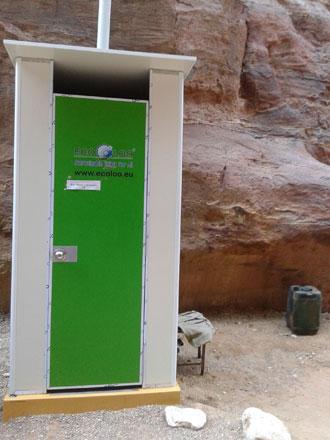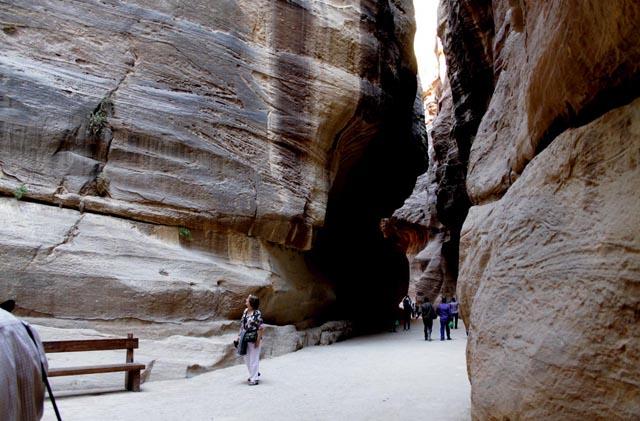You are here
Project aims to promote biodiversity conservation in tourism sector
By Merza Noghai - May 21,2016 - Last updated at May 23,2016

Authorities in Petra in cooperation wih the UNDP have installed four environment-friendly toilets in places that lacked such facilities. The utilities are able to convert waste into organic fertilisers (Photo by Merza Noghai)
PETRA — Although some 80 per cent of Jordan’s area is arid, the Kingdom’s location between three continents — Asia, Africa and Europe — gives it an “enormous environmental importance” by having a biological diversity representing the three of them, according to an environment preservationist.
Jordan has 2,500 species of plants that represent 1 per cent of the world’s species, including 100 native and 375 rare groups, said Majid Hasanat, the manager of a project, titled “Mainstreaming biodiversity conservation in tourism sector development in Jordan”.
The project covers three locations: Dibbeen Forest Reserve, Rum Reserve and Petra Archaeological Park (PAP), and is implemented by the UNDP and financed by the Global Environment Facility, which has contributed $3.5 million.
During a media tour organised by the UNDP late last week in Petra to acquaint the public opinion with progress in the 2014-2018 scheme, Hasanat said there are 47 endangered animal species in Jordan, a matter which requires efforts to preserve them and limit the effects of “uncontrolled tourism” on the nature.
“The project has three main goals, including adopting an effective framework to protect biodiversity through alleviating the effects of tourist activities,” the manager highlighted.
He added that the second goal stipulates building up efficient institutional skills of planning, follow-up and commitment to respond to any possible threats of tourism against biodiversity in areas included in the project.
The third goal is related to developing the administration of targeted areas through enhancing resources and tourist planning, as well as giving local communities a role in the management of these locations, Hasanat noted.
The tourism and municipal affairs ministries, Petra Development and Tourism Region Authority (PDTRA), Aqaba Special Economic Zone Authority and the Royal Society for the Conservation of Nature are partners in implementing the project, in cooperation with the planning and international cooperation and environment ministries.
In Petra, the scheme has so far succeeded in installing four environment-friendly toilets in places that lacked such facilities, a first in Jordan, Hasanat said, adding that these utilities are able to convert waste into organic fertilisers.
“Around 420 tourists use the unit located near the Treasury site, producing some 120 litres of concentrated liquid fertiliser each week,” the agricultural engineer said, noting that the fertiliser is used in PDTRA’s nurseries.
Other achievements of the project in Petra comprise updating information boards at archaeological sites, building visitor centres and providing special vests for service providers to make it easier for tourists to spot them, he added.
Hasanat also acquainted media representatives with other goals expected to be realised by the end of 2016, including the production of a short film that highlights biodiversity in the archaeological site and printing brochures on biodiversity in the rose-red city.
“Creating a mobile app on biodiversity and declaring Petra as national nature reserve in Jordan are two other accomplishments on the scheme’s drawing board,” the project manager added.
Imad Hijazin, the vice chief commissioner of PDTRA and the commissioner of PAP, said that PDTRA made successful partnerships with international organisations — such as UNDP, UNESCO, USAID and JICA — to create a balanced relation between people and the place to protect archaeological sites.
“PDTRA is currently working with UNESCO and UNDP in preparing a management plan to regulate tourist movement in archaeological sites and ensure that urban planning would accord with the identity of the city,” Hijazin added.
He also said that PAP’s area is around 264 square kilometres, which entails there is so much to do, especially that the tourist activity in the park is focused on the main trail extending from the Siq to the Treasury, that forms only 5 per cent of PAP’s total area.
Tahani Salhi, the director of the archaeological resources department at PAP, said that Petra was designated as a UNESCO world heritage site in 1985, and 70 per cent of its local communities depend on tourism as a source of living.
Related Articles
PETRA — In 2008, local community members met to discuss a project aimed at protecting the natural heritage in Petra, which resulted in some
Visitors to Petra dropped by 12 per cent in January compared with the same month last year, according to the Petra Archaeological Park (PAP).
PETRA — In what has been called a “benchmark” decision, the rose-red city of Petra on Tuesday joined the National Protected Areas Network, a
















